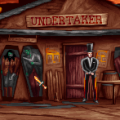Up even into the 2000s, people were still trying to make the Myst formula work for them. A ton of adventure game developers used the basic skeleton of the point and click classic endlessly, including Wanadoo Edition. It was a sister company to Microïds for awhile, owned by the same company, and silently disappeared in 2003. They helped publish a significant number of titles during their existence, but had only developed a small handful of their own. Necronomicon: The Dawning of Darkness is quite the attempt at an original project, though. It’s a story based in the H.P. Lovecraft mythos, and it goes in the directions one would expect. But the age of this game shows HARD.
The story follows one William H. Stanton, the most generic of protagonists imaginable. He’s just a nice white guy who lives in a nice house and has no distinct personality of his own. He’s also friends with a guy named Edgar who pops in his house one day to give him an occult triangle item and tells him to never let anyone have it, including himself. A doctor soon follows after Edgar has left and tells William that his friend is probably completely looney tunes and he needs the stale saltine to look into what’s going on with Edgar. Bah blah blah dark horrible secrets, blah blah resurrected alchemist, blah blah on the verge of all madness upon learning the horrifying truths of existence blah blah. You know, the usual Lovecraftian yarn.
Necronomicon is such a weird game in terms of writing. They managed to create a plot and story, but almost every line of dialog is dry exposition or moody vagueness that fails to be moody or vague. Edgar’s possession could not be more obvious, and Will’s reaction is on par with Marky Mark saying “nooooooo” to the old lady in The Happening. The story never really works because there’s no character or personality in the game to be found… except from the actors. Once again, cheesy bad acting saves the day.
The voice acting is the usual level of ridiculousness at points, especially with side characters. The shop owner, Crumb, comes off as a very grumpy Wallace Shawn, and he is just a gift that needed more screen-time (“It’s cheap at half the price!”). Others are just jarring in amusing ways about how casually they talk about disturbing subjects, especially Edgar’s doctor, whom also lives so deep in uncanny valley that he can’t see the sun over the hills anymore. “Well, it seems your friend has been practicing occult magic to summon horrific god monsters! Quite the problem.” That is, like, half of his dialog. The game is more of an unintentional comedy than horror most of the time, even in one of the most dramatic scenes in the entire game. It still comes off as comical because your robotic main character has to try emoting while murdering another human being. It’s so bad it’s almost adorable.
The presentation only adds to all this. The character models are ugly as sin, even for the early 2000s, with cold dead eyes and barely changing expression, not to mention the awful hair textures. It’s astounding how much better 2003 models from Microïds look in comparison, and remember this released only two years before. The world itself is very moody and makes great use of shadows and darkness, but it suffers from a lot of it being completely pointless and uninteresting. The final area has some creative geometric strangeness and cool color patterns, but it’s too little, to late by then. The more baffling issue is that the ingame graphics are so much worse than the cutscene graphics, heavily pixelated and murky. These two graphical styles look like they came from entirely different games. The second disk segments fix a lot of this with a heavy layering of shadows, but it’s very distracting for every other area. The music also ranges from effective to comical. Every time you quit the game, a cheesy early 2000s euro-techno track plays. Because when you think eldrich horror, you think electronic dance music.
That’s not to say the game isn’t enjoyable. There are moments where the game succeeds at making an atmosphere of dread. It also tells stories with the environment better than most games under Microïds development flag, less overt and unfitting details (yes, because it completely makes sense for a serial killer to write “DISTURBED” and spray-paint a skull in the middle of the same crime scene), more subtle touches. Interaction is still a bit on the low side, but that does help make some pixel hunting less grating by making it clear what you can and can’t interact with. As for puzzles, they’re okay. It’s mostly following directions, and the few parts requiring you to figure something out can easily be solved with random clicking. Only a pitfall area during the second disk sticks out as particularly challenging, but in all the wrong ways. The sequence is just pure trial and error. The last area is the only time the puzzles feel like they require careful though, honestly.
By the time the game ended, it came off more as an interesting oddity than anything else. Lovecraft has been done so much better by so many other designers, and Necronomicon offers little in the way of graphic adventure excellence. But it is certainly entertaining in a bad horror film sort of way. This is perfect riffing fodder, and you can definitely get some chuckles from it. Just be warned: if you hunt it out, avoid the Steam version. It was released with a bug that leaves out a major cutscene and grays out a menu you need to reach the final area of the game. While a save file to reach that final area was later released, the first problem remains unfixed, so you may have to hunt down a PS1 or old PC release if you want to properly play it.


